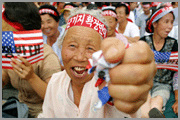NO US BASE | NEWS | PHOTO | CONTACT

|
1) Sino-Japanese War and Russo-Japanese War Foreign bases in Pyeongtaek first arrived during the Sino-Japan War. From 1894-95, in an attempt to take control of Korea, China and Japan went to war. However, the war took place neither in China or Japan, but in Korea. War broke out between the two countries, and Japan emerged in a great victory. One can only imagine how hard both sides fought. Even today, through oral history, people describe the fighting as if the ¡°city of Asan and Pyeongtaek were ready collapse.¡± From 1904-05, Japan waged a war with Russia in the (Russo-Japanese War). Again, however, this war was fought not on Japanese or Russian soil, but in Korea. Pyeongtaek again became an outpost for foreign military bases. 2) Construction of Japanese Bases in Paengsong, Anjungri and Daechuri Emerging victorious from two wars, Japan was able to use Korea as a stepping stone for its colonial advance. Thus during the early years of World War II, in 1941, the Japanese established bases in Paengsong and Anjungri. If Pyeongtaek residents survived the initial occupation, they were mobilized by the Japanese to aid in the construction of bases. The equipment they used were nothing more then picks and shovels. Using human strength, hangars and bases were built where farms and hills existed. Many people also died as parts of mountains collapsed while digging roads. Japanese bases occupied an area of about 300,000-400,000 pyeong. Residents were forced off the land, but despite stripping away their land, they were not compensated a single penny. 3) Liberation and Entrance of the US Military As soon as Korea became liberated, the Japanese base in Anjungri was taken over by the US military. Other Japanese bases also remained. Equipment and facilities used by the Japanese also remained As US military units began expanding, nearby residents were employed as ¡°house boys¡± by the US military or in construction projects. Children aged 15-16 were also ordered by US servicemen to clean or run errands. Because the US military used bulldozers to construct bases, in a short span of time, hills and farm fields were converted into military facilities. Once again, residents from surrounding villages such as Daechuri, Anjungri, Doojungri, Hamjungri, Naeri, or Dongcahngri were not given any say as their land was taken away The US obviously expanded bases during the Korean War. But even after the war, the bases continued to expand. In 2005, the base at Anjungri (Camp Humphreys) today covers an area of 1,500,000 pyeong 4) Origins of Osan Airbase at Songtan Osan Air Base was built at the height of the Korean War on December 1952. Villagers in Yari, Jungbongri, Shinyari, and Gamagol were removed from their land in the process. Some residents left for other cities such as Seoul, Yongin, Pyeongtaek, and Ansan. But others had no where to go and gathered by the bank of Jinwooi stream. The villagers spent a miserable winter in a few tents, living off flour and rice distributed by the U.S. Army. As spring approached, the villagers built huts, but lost everything due to flooding. The villagers experienced much blood and tears living as wanderers without a home. After the war, the U.S. continued to expand Osan Air Base. In 1960, rumors spread that the Ministry of National Defense (MND) would compensate villagers. But instead, the money was given to land brokers, even including the MND officials who managed the base land property. Of course, after forming the ¡°Resident Commission to Facilitate the Withdrawal of the Air Base,¡± and only after years of fighting, were some people able to receive compensation. Currently in 2005, after expanding Osan Air Base 13 times, the base covers more than 2,000,000 pyeong of land.
¢º Suspending Imminent Domain Land Takeover in Pyeongtaek On August 8, 2005, the Ministry of National Defense (MND) announced it would begin the process of imminent domain and take by force the remaining 1,200,000 pyeong of land not yet purchased by the MND. Military officials state on August 8 that of the 3,490,000 pyeong of future land necessary for base expansion in Pyoengtaek and Paengsong, and Osan Air Base, deliberations over 2,290,000 million pyeong of land have already been concluded. According to the Land Management Project Board, the arbitration process over the remaining 1,200,000 pyeong of land will be proposed in September. The arbitration judgment will be concluded in November. And in December, the process of land take over will likely begin. About 200 families live on 680,000 pyeong of land not yet transferred to the MND (650,000 pyeong in the Paengsong region and 30,000 pyeong around Osan Air Base). Land not yet transferred also includes 200,000 pyeong owned by Sejong University, and 208,000 pyeong of land whose ownership and registration is unclear. Also included are ancestral and inherited land. The end of November is the tentative date when the arbitration process for the Land Management Process is decided. The MND stated that if land owners request to sign an agreement before this date, they would deal with the [land transfer] process. The MND also stated, ¡°There will be no significant difference in compensation between those who sign an agreement with the MND and those who seek compensation elsewhere.¡± From last August, of the entire 3,490,000 pyoneg of land to be transferred for base expansion, 96% of the land for Osan Air Base and 60% of the land in the Paengsong region (Camp Humphreys) has been signed and transferred to the MND. |
copylefted by Korea Coalition against U.S. base expantion in Pyeongtaek